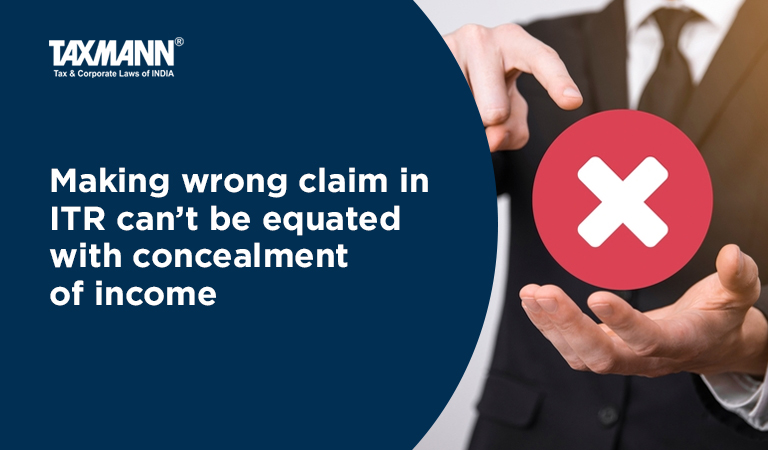Making wrong claim in ITR can’t be equated with concealment of income
- Blog|News|Income Tax|
- 2 Min Read
- By Taxmann
- |
- Last Updated on 9 June, 2022
Case Details: Pawan Garg v. ACIT - [2022] 138 taxmann.com 471 (Chandigarh-Trib.)
Judiciary and Counsel Details
-
- N.K. Saini, Vice President & Sudhanshu Srivastava, Judicial Member
- Sudhir Sehgal, Adv. for the Appellant.
- Dr. Ranjit Kaur, Sr. DR for the Respondent.
Facts of the Case
The assessee was a partner in a firm engaged in the dyeing and finishing of textile yarn. During the assessment, Assessing Officer (AO) noticed that assessee had claimed long-term capital loss (LTCL) in respect of property that had been gifted by him to his son. The assessee also had long-term capital gain (LTCG) which was set off up to the amount of LTCL claimed by him.
The assessee was asked by the AO to explain why LTCL claimed by him may not be disallowed. Assessee accepted that there was a mistake due to some typographical error. Accordingly, AO disallowed LTCL, and said amount was added to the income of the assessee. AO also imposed a penalty on the assessee against said addition towards concealment of income.
On appeal, the CIT(A) upheld the order of AO. Aggrieved-assessee filed an instant appeal to the tribunal.
ITAT Held
The Tribunal held that the assessee had gifted one plot to his son and claimed LTCL in the return of income. He also had LTCG and as a result of the impugned LTCL, the LTCG came to be reduced by the amount of capital loss so wrongly claimed.
It should be noted that the amount of capital loss had been duly mentioned in the computation of income as well. Therefore, there was no concealment of any material fact by the assessee.
At best, it can be said that there was an incorrect claim or a wrong claim but there was not a false claim by any measure. There was only a mistake in the legal sense that the gift made by the assessee to the son was considered as a transfer in the computation of income and the resultant figure was shown as a capital loss.
It was also a fact on record that the assessee had accepted the same at the time of assessment proceedings. Considering the fact of the case, it can be concluded that no penalty was legally imposable on the assessee.
List of Cases Reviewed
-
- Price Waterhouse Coopers (P.) Ltd. v. CIT [2012] 25 taxmann.com 400/211 Taxman 40/348 ITR 306 (SC)
- CIT v. Reliance Petroproducts (P.) Ltd. [2010] 189 Taxman 322/322 ITR 158 (SC) (para 8.2) followed.
List of Cases Referred to
-
- CIT v. Reliance Petroproducts (P.) Ltd. [2010] 189 Taxman 322/322 ITR 158 (SC) (para 8.1)
- Price Waterhouse Coopers (P.) Ltd. v. CIT [2012] 25 taxmann.com 400/211 Taxman 40/348 ITR 306 (SC) (para 8.2).
Disclaimer: The content/information published on the website is only for general information of the user and shall not be construed as legal advice. While the Taxmann has exercised reasonable efforts to ensure the veracity of information/content published, Taxmann shall be under no liability in any manner whatsoever for incorrect information, if any.

Taxmann Publications has a dedicated in-house Research & Editorial Team. This team consists of a team of Chartered Accountants, Company Secretaries, and Lawyers. This team works under the guidance and supervision of editor-in-chief Mr Rakesh Bhargava.
The Research and Editorial Team is responsible for developing reliable and accurate content for the readers. The team follows the six-sigma approach to achieve the benchmark of zero error in its publications and research platforms. The team ensures that the following publication guidelines are thoroughly followed while developing the content:
- The statutory material is obtained only from the authorized and reliable sources
- All the latest developments in the judicial and legislative fields are covered
- Prepare the analytical write-ups on current, controversial, and important issues to help the readers to understand the concept and its implications
- Every content published by Taxmann is complete, accurate and lucid
- All evidence-based statements are supported with proper reference to Section, Circular No., Notification No. or citations
- The golden rules of grammar, style and consistency are thoroughly followed
- Font and size that’s easy to read and remain consistent across all imprint and digital publications are applied








 CA | CS | CMA
CA | CS | CMA


